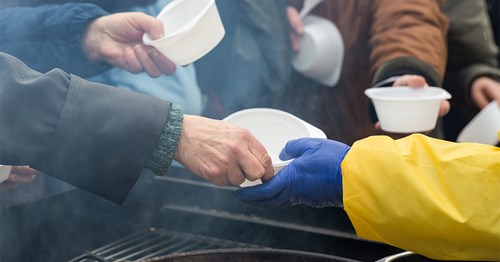Gaps in the social safety net have become apparent as public health leaders try to halt the spread of the virus.
The public health community has strongly encouraged social distancing and in some areas shelter in place protocols to protect the health of individuals across the country. But the strategies to protect people’s health have revealed significant disparities for those who are homeless or housing insecure, have limited food security, or live in rural regions.
Key social determinants of health have worsened because of the coronavirus pandemic, reports Sara Heath in an article for PatientEngagementHIT.

The homeless have nowhere to practice social distancing, which puts them at an even higher risk for the coronavirus0020. Just under a half a million individuals went homeless on any given night in the U.S. during 2018, the most recent years for which federal agencies have data. About 35 percent of those individuals are found without shelter, sleeping in sidewalks, parks, cars, or abandoned buildings. The remaining 65 percent typically find refuge in homeless shelters, transitional housing, or other emergency shelters. This makes it especially difficult to limit large gatherings, avoid public spaces, and maintain a six-foot distance from others, which are all guidelines for social distancing.
The elderly and vulnerable populations have little food security. Although individuals have stocked-up on food and essentials to last for weeks or months, many seniors either can’t afford to buy in bulk, feel apprehensive about going into stores, or don’t have transportation. It’s made it especially difficult and dangerous for low-income seniors who typically rely on group meals at senior centers or food banks to feed themselves.
A little over 8 percent of households with an elderly individual living in it are food insecure, totaling 2.9 million households without adequate access to food, according to the Center on Budget and Policy Priorities. At the same time, the Kaiser Family Foundation reports that 7.2 million adults live at 100 percent of the federal poverty level and 21.4 million live at 200 percent of the federal poverty level.
Older adults are less likely to receive food assistance through programs like SNAP because they are unaware of the program or don’t know how to enroll.
Access to health care in rural areas is limited. Geography has been a barrier to health care for a long time, and it’s been especially difficult for individuals and families during the COVID-19 outbreak, many of whom are older adults with multiple chronic conditions and therefore at a higher risk for coronavirus. With the nearest providers long distances away, individuals are unable to assess their health status or have access to a test. Telehealth has become a great alternative, but it still poses a challenge for rural areas with limited access to the required internet connection.
“The question of the social determinants of health amid the coronavirus outbreak are expected to continue,” Health concludes. “As the economy takes a hit after businesses deemed non-essential must shutter their doors, job security becomes precarious. And with that, incomes plummet and the social safety-net could falter.”
